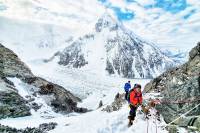COVID in Everest Base Camp: An Expert Chimes In
Reports of a COVID outbreak on Everest have sparked concern and scrutiny. Expedition guide Adrian Ballinger spoke with us about the issues around COVID safety on Everest.
Headlines swept across the internet this week after reports that a climber on Mt. Everest tested positive for COVID-19. Outside magazine cited an anonymous source who reportedly said one person had to be helicoptered off the mountain to a Kathmandu hospital for what was believed to be high-altitude pulmonary edema (HAPE). Outside reported that after arriving at the hospital, the unidentified climber tested positive for COVID.
Shortly after, ExplorersWeb identified the hospitalized man as Norwegian climber Erlend Ness. Today, some news outlets in Asia reported that Ness confirmed his COVID diagnosis to French news agency AFP. But GearJunkie hasn’t been able to confirm any reports from AFP or Ness on his diagnosis.
So we reached out to Adrian Ballinger, adventurer and founder of Alpenglow Expeditions, which routinely takes clients up Everest. Ballinger made the decision previously not to take climbers up Everest this season over his concerns about the pandemic and climbers’ safety.
While we don’t yet know if there’s a confirmed COVID situation on Everest, Ballinger weighed in on why the danger of such an outbreak on the world’s highest peak is so great.
Adrian Ballinger: COVID Risk on Everest
GearJunkie: Why is the COVID risk so high on Everest?
Ballinger: The first apparently confirmed test of COVID-19 on Everest is no surprise to anyone who has worked there in past years. We can be almost sure there have been other cases already this year that were misdiagnosed or hidden, and that there will be more.
The mountain has almost record numbers on its Nepali side (the Chinese side of the Mountain is closed to foreigners), camps are crowded, and mixing between team members, support staff, and countless people traveling into Base Camp each day means the virus can easily spread.
This is combined with the challenge of diagnosing COVID early when so many members and workers have COVID-similar symptoms from altitude sickness or “normal” upper respiratory ailments. It is the perfect setup for a super spreader event. This is combined with cases rising in Nepal, and a massive outbreak in India, which shares an open border with Nepal.
Are you aware of the safety protocols that were in place, and in what way(s) they were ineffective?
[There is] no management of safety protocols by [the] government. Reports say no enforcement of quarantines or testing schedules in Kathmandu before climbers left for the mountain.
Some teams are attempting to isolate from other teams, but this is almost impossible with daily deliveries coming from down valley by yak and porter. Nepali cooks and Sherpa spend time with friends and family in Base Camp, and when on rest, return to their villages — and foreign climbers bend the rules.
Have you seen high demand for this post-COVID season?
Yes.
What do you think needs to happen now?
Similar to all of the issues on the Nepali side of Everest, the Nepali government needs to be actively involved in Base Camp and on the mountain and to actually have the power to fine and remove teams that are not following common-sense regulations. Rapid testing at Base Camp on a regular schedule for all the workers involved in climbing the mountain would be another good step.
Has there been a consensus among other guides on abstaining from expeditions, or is everyone deciding on their own?
While we did not all come to the same conclusion and path of action, I’ve been in regular communication with the leaders of the companies who have a similar mindset of safety and ethics on our international expeditions. It’s a difficult time to say what’s right.
We are 100% confident in our decision to not run an Everest expedition in Nepal this spring.
To your knowledge, are there any unique dangers to a COVID case on the mountain folks should be aware of?
Yes, of course. Our respiratory systems are in constant extreme battle throughout an Everest climb. This is both with altitude (especially the risk of HAPE) and upper-respiratory viral and bacterial infections. Adding COVID symptoms to these “normal” risks is dangerous. This is combined with the challenge of actually diagnosing COVID symptoms versus HAPE. Initial reports are the [alleged] Everest COVID case was initially diagnosed as HAPE.
Can you corroborate the reports of COVID on Everest?
Since I am not there, I cannot. However, this is not the first evacuation from Base Camp for COVID this season that I have heard of from guides on the mountain. Others have been kept quiet thus far. So I have no reason to doubt this report.
Of course, we should be careful spreading rumors until these cases can be and are confirmed. I hope operators and suppliers (as well as individual climbers) will openly share information so the severity of the situation can be assessed and managed. Hiding cases could lead to many more.
The post COVID in Everest Base Camp: An Expert Chimes In appeared first on GearJunkie.

